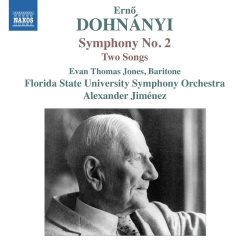| 
|
Erno DOHNÁNYI (1877-1960)
Symphony No. 2 (1944) [54:49]
Two Songs, Op. 22 (texts by Wilhelm Conrad Gommoll): No.1 Gott [4:43]; No.2 Sonnensehnsucht [6:13];
Evan Thomas Jones (baritone)
Florida State University Symphony Orchestra/Alexander Jiménez
rec. Ruby Diamond Concert Hall, Florida State University, 1-3 March 2013
NAXOS 8.573008 [65:44]
Dohnányi’s Second Symphony was composed toward the end of the Second World War but its large canvas reflects not so much his wartime experience as his own artistic credo as a Romantic composer. Of the symphony and its philosophy he wrote: “The goal is the end of the glorious fight. The goal is death; life is a struggle”. This recording of the final revised version by the Florida State University Symphony Orchestra is quite appropriate because he taught there for ten years while he was living in the USA. The definitive score of the Second Symphony now resides at the Florida State University.
This seldom played symphony is a programme work for a large orchestra on the philosophy of mankind. It’s huge, running for just under the hour mark and it has its moments. The first movement opens dramatically with a theme on the strings that is taken up by the woodwinds. The scoring has the opulence of Richard Strauss but when the poignant second theme is announced on the cellos one is immediately in a sound-world closer to Korngold. Indeed the central material of the movement is reminiscent of film music and when the main theme returns on the brass the similarity to the tune from the film Back to the Future is uncanny. This movement is a melodious romp that finishes in spectacular fashion. The slow movement is pure love music with a cor anglais theme representing Eve in the Garden of Eden. This is highly perfumed music with a heart-warming, controlled passion. The strings sing out and take us into a world of romantic nostalgia. I’m afraid to say that my enthusiasm for the opening movements doesn’t stretch to the third movement and the finale. The beautiful Adagio is followed by a most bizarre little Allegro that just doesn’t seem to fit into the overall symphonic scheme of the work. This is a four minute burst of circus music. It’s something that is more akin to the music you would encounter in the Jazz Suites of Shostakovich. Does it sound like the third movement of a romantic symphony? For me the answer is no. The finale is in three parts. First of all there is a set of five variations based on a quotation from Come, Sweet Death by J.S. Bach. This is followed by a lengthy triple fugue that demonstrates the composer’s high level of craftsmanship. The variations and fugue are both musically interesting but they do not successfully fuse into a satisfying structure. The fugue is interrupted by a side drum and the final coda brings back the very opening theme of the symphony and the ending is dramatic, Korngold-like but somehow unsatisfying. It’s all a bit hollow. This is to my ears a symphony of two halves. Others may feel differently about it.
The orchestra plays well throughout and does justice to the symphony. Strings are sweet but lightweight compared to the top professional bands and maybe the horns and trumpets could have come out more. The recording is opulent and spacious.
The two songs, without being especially original, are worthy additions to the catalogue. Gott, with its memorable rising and falling theme, takes us back into Richard Strauss territory. The climax of the song to the word “Gott” introduces a telling use of hymn-like chords before the rising and falling motif returns. Sonnensehnsucht could have been written by Wagner. In a mood of sinister darkness, new themes are introduced over the six minute span of the song and the mood is finally lightened when heroic fanfares announce the rising of the sun. These two songs, beautifully sung by Evan Thomas Jones, are dramatic and uplifting.
This CD isn’t a complete success musically but when it’s good it’s very good indeed. Lovers of lush romanticism will be more than happy to come across it.
John Whitmore
 |
 |
|
